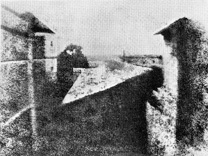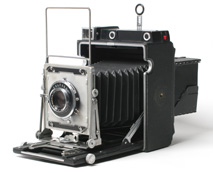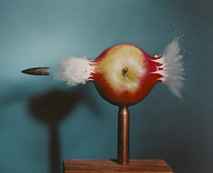 |
|
NICÉPHORE NIEPCE
VIEW FROM HIS WINDOW AT GRAS, 1826.
|
| An eight hour exposure. |
|
 |
|
THE SPEED GRAPHIC CAMERA
BY GRAPHLEX
First introduced in 1912
|
Its name does not require any comment.
|
|
 |
|
HAROLD EDGERTON
BULLET THROUGH APPLE
1964
|
| Edgerton, an engineer, pioneered electronic stroboscopic photography. |
|
 |
|
|
| This superposition of different exposures on a single sheet of film required a total shooting time of several minutes. |
|
|
Since the invention of photography its practitioners had to deal with the question of time : time for exposure, time for processing, stability in time … and the time that the photographer takes between the initial intention of an image and the concretization that makes it visible to all.
Digital technologies bring their share of accessories to shorten time. but this need can be found during the entire history of photography in a succession of small revolutions intended to reduce exposure time, the time necessary for the manipulations of the camera as well as the processing time. Factory made surfaces and chemicals helped us save time. Automatic features of all sorts work in the same direction all the way to the four corners of our darkrooms. New tools with ever faster shutters, software's automated functions, faster and faster printers, all contribute to this endless race.
In 1826 Nicéphore Niepce gave birth to photography. This required an eight hour exposure. The necessity to reduce time exposure was thus evident from the start. Daguerre reduced it to a few minutes. As early as 1851, it was a matter of seconds with Frederick Scott Archer's Collodion. Gelatin bromide silver emulsions (Richard Maddox, 1871) and roll film (George Eastman, 1888) transformed photography into an industry with more research capabilities. One could now photograph 100 exposures before having to send the camera to the Kodak factory for processing and reloading. The length of the shooting sessions could be greatly shortened. In 1925 Leica put the first still camera using 35 mm movie film on the market : 36 views before the photographer had to reload by himself. Nonetheless, the film still needed to be processed in the darkroom. In 1947 Edwin H. Land invented instant film for Polaroïd : The result was ready for framing in less that 2 minutes. In 1963 curtain shutters reached a1000th of a second. Electronic strobes with a flash duration of a10,000th of a second made it possible to freeze the motion of flapping wings. Film and processing gained faster and faster speed. Initially built-in and then automated light meters, motor drives to advance and a few years latter to rewind the film, continuous exposure, automatic focus and other innovations contributed to saving time. Now shutter speed in digital reflex cameras has reached the 8000th of a second and direct connections to ultra fast printers can produce photographic prints in less than one minute!
Let's catch our breath for a moment, … the race is not over yet.
On the other hand photography, like all other forms of expression, requires time; Not only production time, but time for the intention, the first spark, to develop, to find form and meaning, to mature. For many years, this maturing time partially overlapped with production time and thus, shrunk with it. It is vital that the former not be sacrificed on the altar of the technical progress. This will most likely take another form. : The time we needed (still need ?) to prepare and process our silver based images will have to be replaced by the necessary time used to study, sort out and finally elect THE photograph among hundreds, maybe thousands of images perhaps captured too quickly.
The digital revolution is most likely to be yet another revolution in a field than has known many, but the race for time will not end here.
For all those who have a passion for images, is this really the most essential matter ? Or isn't more than ever time for us to take our time ?
|